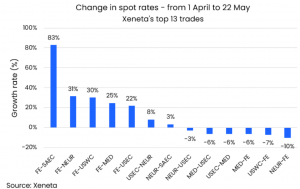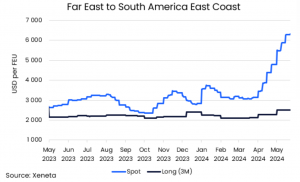Weekly Container Rate Update l Week 21 l A wider view of the dramatic spike in ocean freight spot rates
Ocean freight shipping has hit the headlines again following rapid increases in spot rates on major trades out of the Far East – but is there more to the story?
Between 1 April and 22 May, average spot rates from the Far East increased into North Europe (+31%), US West Coast (+30%), Mediterranean (+25%) and US East Coast (+22%).
The reasons behind the dramatic increases on these four major trades was covered in last week’s Xeneta update, prompting speculation of an early peak season in 2024.
However, for all shippers, the most important trade lanes are always the ones they utilize in their own supply chains, whether that is a major trade such as the Transpacific or a smaller inter-regional feeder service.
This week’s Xeneta update will therefore look beyond the four fronthauls out of the Far East to understand if rapid spot rate increases have been seen on other top world trades.
Some spot rates continue to slide
Across Xeneta’s top 13 trades, which covers both major global fronthaul trades as well as the biggest backhauls, seven have posted an average spot rate increase since 1 April.
That means the remaining six top trades have seen spot rates continue to fall.

(Graph key: FE – Far East; SAEC – South America East Coast; NEUR – North Europe; USEC – US East Coast; MED – Mediterranean; USWC – US West Coast)
Rapid increase on Far East to South America trade
By far the biggest increase in rates across these top trades is from the Far East to South America East Coast, up by 83% since 1 April to stand at USD 6 320 per FEU on 22 May.
This is particularly notable given spot rates to South America East Coast did not see the same level of increase as other top trades during the Red Sea crisis, rising by ‘only’ 26% between 14 December 2023 and 8 January 2024.
So, while other trades remain below their Red Sea crisis peak despite the recent increases, the current spot rate of USD 6 320 per FEU from the Far East to South America East Coast is the highest it has been since October 2022.
Similar to the other top trades out of the Far East, the rallying spot market on the South America East Coast trade has driven up the spread between spot and long term rates.
The spread increased from USD 1 170 per FEU on 1 April to USD 3 815 on 22 May. This is predominantly due to the rapid rise in spot rates, with long term rates increasing by only USD 220 per FEU in that time.
However, even this small increase of USD 220 per FEU means the Far East to South America East Coast has seen the biggest increase in long term rates since 1 April across Xeneta’s top 13 trades.

Shippers will welcome softening spot market
There is better news for shippers elsewhere on the Xeneta top 13 trades where spot rates have fallen over the past two months.
While these decreases are not as dramatic as the increases found on the Far East outbound trades, it is still welcome respite for shippers who have been exposed to a volatile market in recent months due to the situation in the Red Sea.
The biggest decrease is found on the backhaul from North Europe to the Far East, where spot rates have fallen by 10.4% since 1 April to land at USD 820 per FEU on 22 May.
Two other backhauls to the Far East included in Xeneta’s top 13 trades have also seen falling spot rates. From the Far East into the Mediterranean, spot rates are down by 6.5% from the start of April, while from the US West Coast they are down by 7.1%.
However, out of the three trades highlighted above which have seen spot rates fall, only the US West Coast to Far East is below where it was at the end of last year.
Despite seeing the biggest decrease out of the top 13 trades since 1 April, the North Europe to Far East average spot rate is still 95% higher than 31 December 2023 (before the Red Sea crisis caused rates to spike).
Mixed outlook on the Transatlantic
Finally, the Transatlantic trades typify the contrasting spot markets across the Xeneta top 13 trades.
The two fronthauls from North Europe and the Mediterranean to the US East Coast have fallen since 1 April, down by 3.1% and 6.3% respectively.
However, in the past few years, these trades from Europe to US East Coast have followed developments on the major trades out of the Far East, only with several months delay.
For example, as rates increase on a fronthaul out of the Far East, carriers tend to shift capacity onto this trade to make more money. This additional capacity often comes from trades such as the Transatlantic, which in turn places upward pressure on rates.
The fact this re-deployment of capacity takes a number of months to complete explains the delayed uptick in rates on the Transatlantic trades.
What next for the top 13 trades?
The major fronthaul trades from the Far East, which have already seen dramatic spot rate increases, can be used a barometer for how the rest of the market may react in the coming months.
If so, then the softening spot market on six of the 13 top trades may be short-lived before upward pressure returns.
However, there are no guarantees and it remains important that shippers use data to monitor the trades within their individual supply chains.
With shippers seemingly frontloading imports ahead of the traditional peak season in Q3, early Xeneta data for June suggests spot rates will continue rising on these top four fronthaul trades out of the Far East.
While it is unlikely a capacity squeeze will see rates increase to the heights seen during Covid-19, reaching the levels witnessed during the Red Sea crisis earlier in 2024 is not out of the question.




